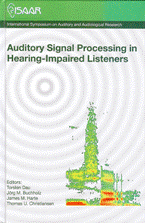An investigation of effective SNR-change through amplitude-compression hearing aids
Abstract
The long-term Signal-to-Noise Ratio (SNR) at the input and output of compression amplification hearing aids (HA) are measured and computed. Systematic changes of long-term SNR from input to output are found. These changes are affected by both compression system parameters and signal properties of speech and noise. Such SNR changes may potentially affect perceptual performance for users of compression HAs. This is also investigated, although the current standing of this work does not provide a clear conclusion.
References
Olsen, H. L., Olofsson, Å., and Hagerman, B. (2005). “The effect of audibility, signal- to-noise ratio, and temporal speech cues on the benefit from fast-acting compression in modulated noise,” Int. J. Audiol. 44, 421-433.
Souza, P. E., Jenstad, L. M., Boike, K. T. (2006). “Measuring the acoustic effects of compression amplification on speech in noise,” J. Acoust. Soc. Am., 119, 41-44.
Additional Files
Published
How to Cite
Issue
Section
License
Authors who publish with this journal agree to the following terms:
a. Authors retain copyright* and grant the journal right of first publication with the work simultaneously licensed under a Creative Commons Attribution License that allows others to share the work with an acknowledgement of the work's authorship and initial publication in this journal.
b. Authors are able to enter into separate, additional contractual arrangements for the non-exclusive distribution of the journal's published version of the work (e.g., post it to an institutional repository or publish it in a book), with an acknowledgement of its initial publication in this journal.
c. Authors are permitted and encouraged to post their work online (e.g., in institutional repositories or on their website) prior to and during the submission process, as it can lead to productive exchanges, as well as earlier and greater citation of published work (See The Effect of Open Access).
*From the 2017 issue onward. The Danavox Jubilee Foundation owns the copyright of all articles published in the 1969-2015 issues. However, authors are still allowed to share the work with an acknowledgement of the work's authorship and initial publication in this journal.


